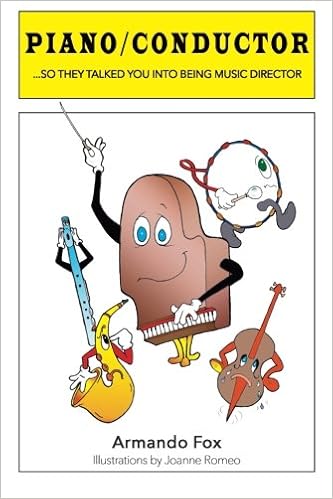Piano/Conductor: So They Talked You Into Being Music Director
Book: Piano/Conductor
Although I’ve had a good deal of formal training in piano performance, musicianship, theory, etc., like most Music Directors working in a nonprofessional setting I never received any formal training on how to do that.
It turns out there’s a lot of non-obvious tasks in that job, and I wrote this book to pull them all together.
Although originally targeted at Music Directors, actors and singers may find it useful too, since it contains a lot of the advice I give when working with actors and singers on musical material–tips on how to learn and practice tricky parts, how to think about character as it relates to the music, how to polish away easily-avoided vocal pitfalls, how to take care of your voice during the run of a show, and so on.
The book focuses on the dual role of the modern MD or Associate Conductor: sometimes you’re leading the orchestra, sometimes you’re a rhythm instrument. And you have to work with the actors (some of whom may also lack formal musical/vocal training) to help them learn often challenging songs, while managing the rehearsal schedule, figuring out which orchestra instruments you can do without, and so on. Substantially all of the techniques are illustrated with examples from the musical theater literature.
Below is the current Table of Contents. The book is available on Amazon in paperback (and soon Kindle) format, and it’s sprinkled with whimsical illustrations by drummer and talented graphic artist Joanne Romeo. If you prefer you can download the PDF for free.
A revised edition is expected Summer 2023 so please check back then!
1 A Music Director's Tour of the Materials
1.1 So They're Talking You Into Being Music Director
1.2 What's In The Box
1.3 The Conductor's Score
1.4 Instrumentation: Types of Ensembles
1.5 Instrument Books
1.6 Doubling and Cross-Cuing
2 Auditions
2.1 Preparing to Hear Auditions
2.2 First Round Auditions
2.3 When You Need More Information
2.4 Making Callback Choices
2.5 Tips to Auditioners for a Successful Audition
3 Teaching the Music
3.1 Planning and Scheduling Vocal Rehearsals
3.2 The Seven Habits of Highly Successful Vocal Rehearsals
3.3 Practice Tracks For At-Home Preparation
3.4 Pitch and Interval Training
3.5 Harmonies and Counterpoint
3.6 Variable-Stress Practice and Long-Line Extraction
3.7 Teaching Tricky Rhythms
3.8 Putting It All Together
3.9 Performance: Putting the Show in Context
3.10 Example: So What (Cabaret)
3.11 Example:Dulcinea (Man Of La Mancha)
3.12 Example: I'm Alive
4 Diction, Rhythm, and Dynamics
4.1 Diction Basics
4.2 Vowels and Consonants
4.3 Diction and Rhythm
4.4 Tempo: Jump On the Entrance
4.5 Dynamics
4.6 Polishing Away Easily-Avoided Pitfalls
4.7 Microphones: A Blessing and a Curse
4.8 Summary and Checklists
5 The Orchestra
5.1 Instrumentation on a Shoestring
5.2 Recruiting Tips
5.3 The Mighty Piano, or Pit Piano for Classical Pianists
5.4 Rehearsal Pianists
5.5 Strings
5.6 Electronic Instruments
5.7 Orchestra Rehearsal Venues
5.8 Preparing the Book for Rehearsal
5.9 Play-Through and Sitzprobe (Sit-n-Sing)
5.10 Tech Week
5.11 Subs
6 Conducting
6.1 Pit Conducting vs. Other Conducting Gigs
6.2 From Pianist to Piano/Conductor
6.3 Hands-Free Conducting
6.4 The Secret Language of the Piano/Conductor Score
6.5 Script Cues: Segues and Safeties and Vamps, Oh My
6.6 Warnings and Starts
6.7 Tempo Changes, Fermatas, Track Marks, Dictated
6.8 Vamps and Safeties
6.9 Underscoring
7 Emergency Arranging
7.1 Transposition
7.2 Part Consolidation
7.3 Doing Your Own Reduction
7.4 Score Analysis
7.5 Reduction and Substitution Strategies
7.6 Example: Assassins
7.7 Example: Man of La Mancha
7.8 Example: {Gypsy
A Technology Resources
A.1 File Sharing
A.2 High Speed Scanners
A.3 Practice Tracks and ``Karaoke'' Tracks
A.4 Music Notation, Transposition, Arranging
A.5 Recruiting Musicians
